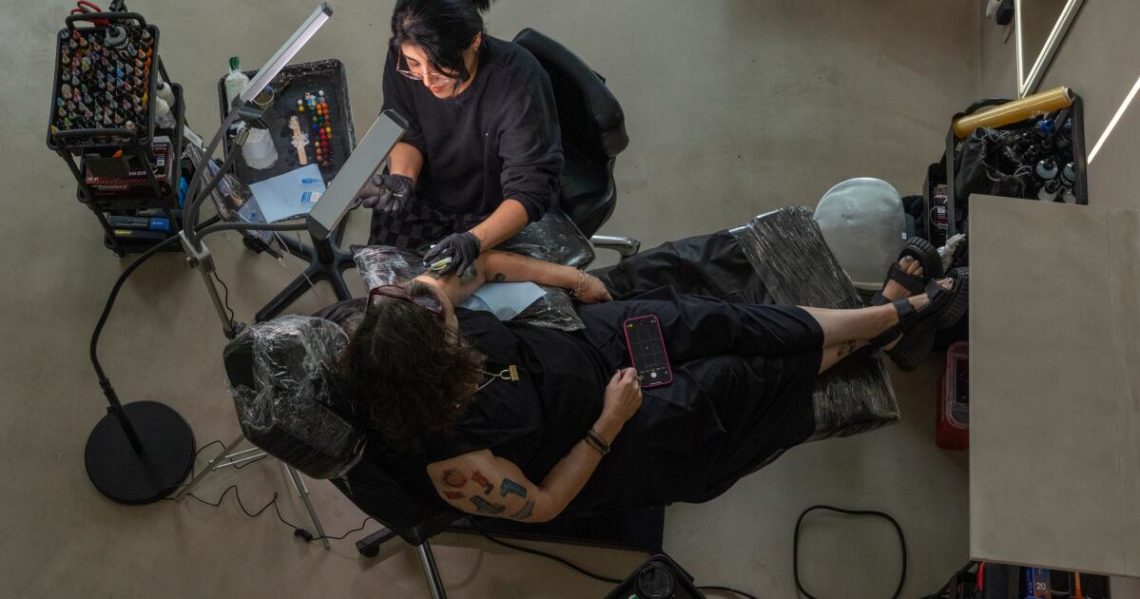Sandee Althouse walked into a Silver Lake gift shop dressed in an almost austere, simple black dress, her curly black hair graying at the temples. She carried herself like an older and accomplished, if somewhat serious, woman — but with a twist. Both of her arms were covered in freshly-inked tattoos, her left arm still wrapped in glistening cellophane.
“Excuse me, but I have to ask: Are these your first tattoos?” I said of the colorful images spanning from the tops of her shoulders to her wrists.
“They are,” she said proudly. “I’ve gotten all of them since May.”
It was September.
“I’d love to know more,” I said, curious about what prompted so many tattoos, in such a short period of time, and all inked later in life.
It turns out that Althouse, who lives in the Bay Area, was on what she calls “a tattoo journey,” in what she describes as a deliberate act of self-care. She told me her husband of 35 years, Josh Wallace, had recently been diagnosed with a serious disease and Althouse, in addition to being heartbroken, had become his caretaker while also working full-time as a radio announcer at KQED in San Francisco.
Getting tattooed is a way for Althouse to shift focus back onto herself, she explained to me, in order to remain strong and resilient — for herself and her family. Sitting in a tattoo studio chair and feeling the ongoing prick of the needle for up to seven hours is a repetitive, almost meditative act that helps ground her in the present moment, she said. According to Althouse, it helps excise the emotional pain, giving it physical form — a release of sorts.
“We’re dealing with a severe diagnosis,” Althouse said of her husband. “It’s a new part of life. Something new has changed him — and me — and I just feel like why not do something that will take me someplace new, a new adventure.”
The act of searching for tattoo images online that she wants to emblazon on her body — mostly of famous 20th century paintings and historically significant neon signs — and deciding where they will go is a creative distraction during such difficult times, she explained.
And talking with the different tattoo artists while they work on her body has forged intimate personal relationships.
“There’s a sensual nature to it — human beings touching you,” Althouse said. “I don’t wear headphones; I like to have conversations. You meet someone new and they’re putting something permanent on you that will change you forever. It’s a very deep connection.”
The journey so far — 17 tattoos to date — has provided sustenance and even inspiration.
Althouse elaborated on all this during a chilly October afternoon, recently, while sitting in the chair at Ganga Tattoo Studio in West Hollywood. She frequently gets tattoos in the Bay Area, but also finds L.A. artists on Instagram that she admires and makes “tattoo excursions” here.
Today, she’s getting a tattoo of Edward Hopper’s 1957 painting, “Western Motel,” which the artist, May Soria, is putting the finishing touches on when I arrive. All of Althouse’s tattoos are done in the detailed, lifelike “micro-realism” style, and the Hopper image is eerily similar to the original work of art. In the oil painting, a young woman in a red dress sits on the edge of a motel bed, gripping the footboard tensely. Enormous windows look out onto a classic car and a vast, open western landscape of mountains.
“I just feel like this woman has a little bit of mystery and strength,” Althouse says, as Soria fine-tunes the woman’s leg. “She allows a lot of room for you to decide what she’s thinking and going to say.”
So does Althouse, who has a deep, sultry radio-announcer voice and often pauses momentarily to ruminate deeply before answering questions.
“I want to be stronger, and I want to be bolder, and I want to have wisdom — and I feel those things are kind of represented by this,” she said of her tattoos.
Althouse had never considered getting a tattoo until shortly before a trip to Italy this May with her husband and two sons, Ethan Wallace, 29, and Xander Wallace, 27. Ethan is heavily tattooed and had “hounded” her for years to get one, but she had zero desire. Then, several weeks before the trip, involved with caretaking responsibilities and trip-planning, the idea somehow, suddenly, made sense. She found an image of an “old timey” radio microphone and “on air” sign and brought it to a tattoo studio in Rome she’d admired the work of online. The artist Giorgia Mastrosanti tattooed it onto the inside of her right forearm, a discreet but still noticeable spot.
“Last year I got into the Bay Area Radio Hall of Fame, which is a pretty big honor,” Althouse said. “I wanted to document how I spent a good portion of my life — and that was in radio.”
Her second tattoo, which she got from Mastrosanti the next day, was of the Carlos Club neon sign in San Carlos on her right upper arm. Several days later she got a ‘40s-era Bakelite radio image on the inside of her left forearm.
In addition to working in radio, Althouse is a fiber artist currently working on needlepoint. “I’m just really connected to art,” she said. “And this [tattoo journey] is a real ongoing art project.”
In late September, Althouse got tattoos of two other famous paintings on the same “gallery wall” that is her left arm: Amedeo Modigliani’s 1917 “Jeune femme (Totote de la gaîté)” and Gino Severini’s “Sea = Dancer.” She got the tattoos from Levi Elorreaga, an L.A. artist who was doing a residency at Black Serum, a studio in San Francisco at the time.
“I’ve never been taken by a painting as much as I was with [the Severini]. Just the vibrancy, there was so much movement to it — it almost sang,” she said.
Althouse’s right arm now features a smattering of historic neon signs — the Li Po Cocktail Lounge in San Francisco’s Chinatown and the View Alcatraz sign, among them. She’s drawn to the brightness and vibrant color of neon signs, adding that they’re “incredible and under-appreciated works of art.”
The process, itself, of designing the “art walls” on her arms is also healing — it provides joy and distraction. Althouse approaches that process as if she were a curator laying out a museum exhibition. She tapes maquettes — in this case, paper cut-outs of the paintings — to her arm, fine tuning the layout. Then she gives her tattoo artist a digital image of the work.
During my visit, Soria worked off of an enlarged image of the Hopper painting on her iPad. As part of the tattoo, Soria designed a Midcentury Modern wooden frame for the painting. She placed stencils of the tattoo on Althouse’s arm before they got started that morning, tweaking the tattoo size and its placement.
“It actually doesn’t hurt that much,” Althouse said, as Soria pokes her arm with a needle that was just dipped into a pot of crimson ink. “Just a little ghost pain. You feel alive.”
Some people might look at her strangely when she’s in the tattoo chair — “what’s that old person doing?” she said. But turning aging tropes on their head is part of the joy of this journey.
“People who get [tattoos] understand,” Althouse said. “And I do think that maybe some people, especially young people, think ‘she’s kinda badass.’ I like that. That’s OK with me.”
Making her way through the world, as a woman in midlife, feels differently now with tattoos.
“You get to middle age and you’re looked over more — you’re not noticed,” Althouse said. “And I feel like I am noticed now. I just like being seen again.”
Soria said she has several clients over 60. Getting tattoos later in life makes sense to her.
“You have more experience in life, so have more stories to tell [through tattoos],” she says. “You know what you want.”
As if on cue, an older man in a baseball cap and rain jacket walks by, leaning in to get a closer look at Althouse’s tattoo-in-progress.
“Stunning. Just stunning,” said Ames Beals, 70. He’s there to have one of his own tattoos, the image of a harmonica with wings, cleaned up. “Can I take a picture to show my wife? I want her to get one.”
“See? It’s never too late to get a tattoo,” Althouse said.
Althouse is now running out of available “canvas” on her body, as she primarily wants tattoos on her arms and legs. She has room for about two or three more. Next up? a Marcel Duchamp painting and, possibly, a Mark Rothko or Ruth Asawa work.
As Althouse heads into hour five in Soria’s chair, the tattoo is nearly finished. It will end up costing $1,500, but is well worth it, Althouse said. (“That’s the other thing about getting them later in life, you have more money,” she added.)
She looks herself over in the mirror, a mix of pride and melancholy on her face.
“I just need to keep propping myself up,” she said. “I need to make myself strong. Because it’s only going to get harder. And this —”
She sweeps her hand over one arm.
“ — this reminds me to do that.”
The post At 65, she got her first tattoo. Now she has 17 and feels ‘seen again’ appeared first on Los Angeles Times.




